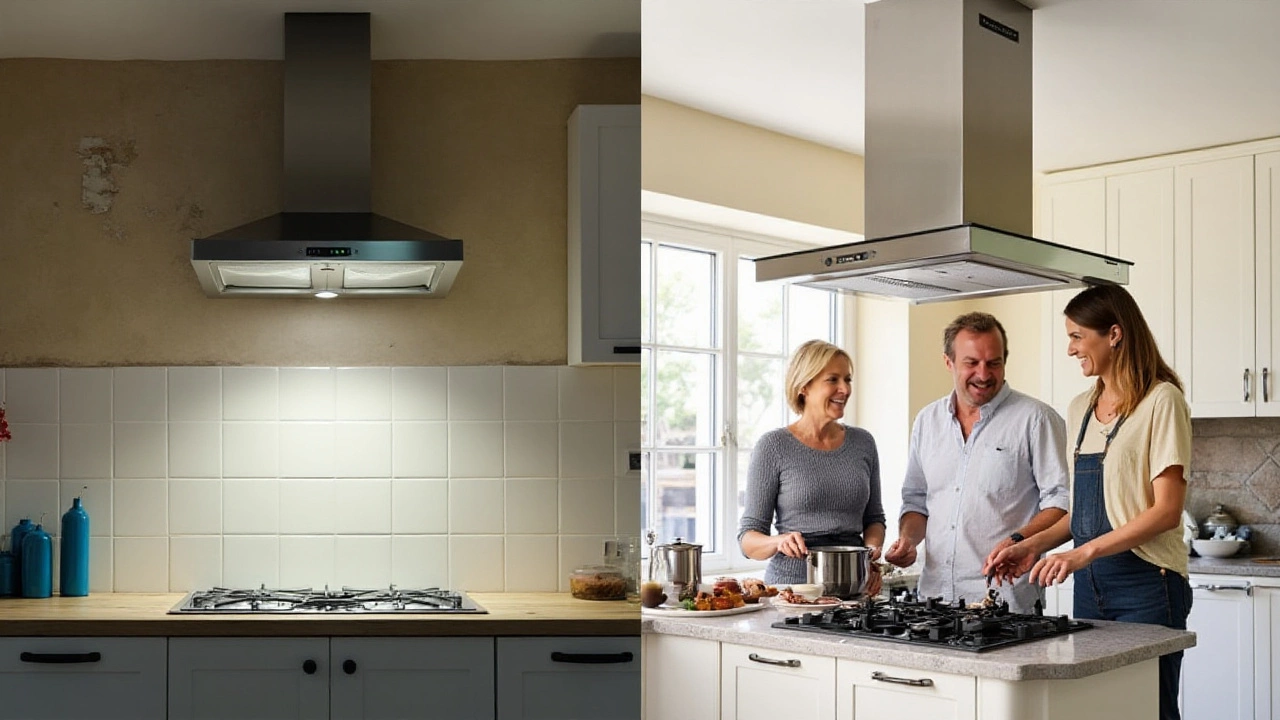Extractor fans might not be the most glamorous part of your home, but they play a vital role in keeping it comfortable and healthy. Choosing the right one can transform your kitchen into a pleasant culinary haven or keep your bathroom free from mold and mildew. Yet, with so many options, it's easy to feel overwhelmed.
In this article, we'll walk you through the essential aspects you need to consider before making a purchase. From understanding different types of fans to knowing how to match the fan's capacity with your room size, you'll find the guidance needed to make an informed choice. So whether you're a home improvement enthusiast or just seeking a little DIY help, our guide aims to make the decision process a breeze.
- Understanding Your Needs
- Types of Extractor Fans
- Sizing and Capacity Considerations
- Key Features to Look For
- Installation and Maintenance Tips
Understanding Your Needs
Before diving into the world of extractor fans, it's crucial to take a step back and assess what you truly need. An extractor fan is essentially the lungs of a particular area in your home, often tasked with purging moisture-laden, stale, or odorous air to create a healthier living environment. Initially, consider which rooms in your abode genuinely require improved home ventilation. Typically, kitchens and bathrooms top the list due to their propensity to accumulate steam, heat, and sometimes undesirable smells.
Kitchens often deal with smoke, odors, and airborne grease, while bathrooms contend with moisture that can lead to mold if not sufficiently controlled. Interestingly, according to several studies, proper ventilation can improve indoor air quality by removing these irritants, thereby reducing the risk of health issues like asthma and allergies. As you evaluate your personal needs, reflect on the room size, the type of activities being performed, and the layout of the space, which will influence the necessary power and type of the extractor fan you'll choose.
Moreover, take into account the noise level that you can tolerate. Some fans are designed to operate very quietly, which could be a significant factor if the kitchen is open-plan and integrates with your living area or if the bathroom is adjacent to a bedroom. Not all fans will suit every scenario, so understanding these specific needs is a vital first piece of the puzzle. A comprehensive assessment boosts the efficiency and satisfaction you'll derive from this unassuming yet indispensable appliance.
“Ventilation is a crucial component of maintaining healthy indoor environments. Whether cooking or showering, the use of appropriate exhaust can significantly contribute to indoor air quality improvement.” — Environmental Protection Agency (EPA)
Before you pick your model, contemplate if the installation is purely functional or if aesthetics matter just as much. In a minimalist home, a sleek, modern-design fan might seamlessly blend with your décor, while traditional homes may call for a more classic style. By genuinely understanding what you require, you expand your options, leading you to choose a fan that's not just fit for purpose but also enhances your living environment in unexpected ways.
Types of Extractor Fans
When it comes to selecting the ideal extractor fan, it's essential to understand the different types available in the market. Each type serves a unique purpose and is designed to cater to specific needs. With modern innovation, these fans have evolved significantly, offering various functionalities that not only improve air quality but also enhance the aesthetic appeal of your living space. Let’s explore the primary types of extractor fans and what makes each type distinct.
Axial Fans
The most common type of extractor fan you’ll encounter is the axial fan. These are best suited for installations directly on walls or windows where they can vent air directly outside. Axial fans work by drawing air in along the axis of the fan and releasing it straight back out. They're perfect for kitchens and bathrooms, where effective ventilation is crucial. Notably, they are ideal for short duct runs, making them a popular choice for domestic use. These fans operate quietly and are typically budget-friendly, although their efficiency may drop if tasked with moving air through a long duct or around bends.
Centrifugal Fans
An alternative to the axial fan, centrifugal fans are used where ducts are needed to be longer or where there is a requirement to move air around corners. In these fans, the air is drawn in from the sides and expelled at right angles, which enhances its ability to move air through ducts. Although often considered noisier compared to axial fans, they are powerful and maintain efficiency over long distances. This makes them suitable for spaces like commercial kitchens or bathrooms situated far from an exterior wall. Their ability to handle high resistances due to filters or complicated duct arrangements is a significant advantage.
Inline Fans
Inline fans provide versatile installments either between ducting or above ceilings. They offer a superb middle ground between the efficiency of centrifugal fans and the simplicity of axial fans. Used predominantly where external wall space isn't available, inline fans are mounted in the attic or ceiling void of the room they’ll serve. Their discrete nature allows them to deliver excellent ventilation without affecting the room's appearance. With properly insulated and soundproofed ducting, these fans can offer quiet and efficient ventilation, being perfect for both residential and commercial settings.
"When picking an extractor fan, consider the room's size, the duct length, and where it will be installed. Each type has its strengths that can cater to your needs in terms of efficiency and aesthetics." - Brian Harper, Home Improvement Magazine Editor
Extracting Cooker Hoods
Specialty types of extractor fans are present in the form of extracting cooker hoods. These are integral in kitchens, pulling away smoke, steam, and cooking odors. They often feature a mix of fan types but are primarily designed for their location above a cooking surface. The choice between ducted and recirculating hoods depends largely on whether you can ventilate directly outside. Models vary in terms of speed, noise level, and design, allowing homeowners to find a solution that fits both their ventilation needs and kitchen style. Robust models can even trap grease, which is crucial for maintaining both the integrity of your kitchen fixtures and the air quality.
Humidity-Detecting Fans
In high-humidity environments, like bathrooms, humidity-detecting extractor fans are an excellent option. These intelligent systems automatically activate when they detect increased moisture levels, offering hands-off operation. This helps in preventing the accumulation of mold and mildew by ensuring the air is consistently refreshed. Modern models may incorporate timers, variable speeds, and even integration with smart home systems, aligning with the increasing emphasis on convenience and efficiency. Investing in this type can pay off in terms of lower maintenance and improved hygiene.

Sizing and Capacity Considerations
When it comes to choosing the right extractor fan, getting the size and capacity right is crucial. The size of the fan directly affects its ability to ventilate effectively, and that's where the concept of capacity, typically measured in cubic feet per minute (CFM), comes into play. Selecting a fan with adequate CFM is essential for ensuring the space is properly ventilated. For instance, the kitchen and bathroom areas are prone to high humidity levels, and without the correct capacity, these areas can quickly become uncomfortable, promoting the growth of mold and mildew.
We should consider a simple formula to determine the minimum CFM required for your space: multiply the room's volume in cubic feet by the recommended number of air changes per hour. The recommended air changes for a kitchen is usually between 15 to 20, while for a bathroom, it's often between 8 to 12. This calculation ensures that the air in the room is replaced frequently enough to maintain a fresh and healthy environment. Keep in mind that local building codes may offer additional guidance or requirements specific to your area.
Home ventilation experts often stress the importance of understanding airflow dynamics. An often-overlooked factor is the length and configuration of the ducting used in the exhaust system. Longer duct runs and more bends can impede airflow, which means you'll need a fan with a higher CFM rating to overcome this resistance. To avoid these common pitfalls, try to select the most direct path possible for the ductwork, minimizing bends and the total length of the duct.
“Proper ventilation is key to maintaining healthy indoor air quality in our homes,” says Dr. Joseph Allen, a noted expert in public health. “Be sure to select an extractor fan that is well-matched to your room size and airflow needs.”
Many people might wonder about the impact of a fan's noise level in relation to its size. As fans work to move air, they inevitably generate sound, and larger capacity fans can sometimes be noisier. It’s important to find a balance that you can live with daily. The sound level is rated in sones; a lower sone rating indicates a quieter model. For a peaceful household environment, particularly in residential areas, it’s advisable to choose a product with a sone level of around 1.5 or less, especially for sensitive areas like bathrooms.
Besides size, aesthetics and installation options should also be considered. Modern extractor fans come in a variety of styles, allowing them to blend seamlessly with your interior design while offering versatile installation capabilities such as wall-mounted, ceiling-mounted, or inline options that can be hidden entirely. To help make an informed decision, review the specifications from the manufacturer carefully and, if possible, consult with a professional to ensure the installation is done correctly and efficiently. Choosing wisely will mean seeing benefits in both air quality and comfort.
Key Features to Look For
When selecting an extractor fan, identifying key features that cater to your specific needs is essential. The range of options available on the market today means that you can find a fan tailored to your exact requirements. These features often determine not only the efficiency of the fan but also how it blends into the aesthetics of your home. By considering these aspects, you can ensure that the fan you choose will effectively enhance your space's air quality and functionality.
One of the primary features to pay attention to is the noise level of the fan. Fans are rated by decibels, with most models falling between 30 and 50 decibels. For a quiet bathroom experience, opt for a fan rated below 30 decibels. Conversely, if you're focused on eliminating kitchen fumes, and the fan's operation noise is less of a concern during cooking, you might consider models on the higher end of the scale. An extractor fan's noise level is a significant aspect, especially for an open-plan space where loud noise can disrupt conversations or television viewing. In this aspect, seeking a fan that balances power and quiet operation can improve your home's comfort significantly.
Another crucial feature to evaluate is the power or extraction rate of the fan. Measured in cubic meters per hour (m³/h), this indicates how much air the fan can move within an hour. This effectively mirrors the fan's performance in improving ventilation. As a rule of thumb, smaller bathrooms may only require around 54 m³/h, while larger kitchens might need at least 200 m³/h to manage steam and odors efficiently. Checking the power rating helps in selecting a fan that is neither oversized, which can lead to wasted energy, nor too small, reducing its effectiveness. Bathroom fans with a higher extraction rate are more efficient in removing moisture, which can help prevent mold growth.
Energy Efficiency
With rising energy costs and increasing environmental consciousness, choosing an energy-efficient extractor fan is more important than ever. High energy efficiency not only saves on electricity bills but also reduces the carbon footprint of your home. Some models may feature an 'eco' setting or include sensors that trigger the fan only when necessary. These fans can adjust their operating speed based on the room's humidity levels or air quality, ensuring maximum efficiency. Such advanced systems are particularly beneficial in spaces with fluctuating humidity, like bathrooms, adding convenience alongside cost savings.
Additional Smart Features
In the age of smart homes, extractor fans have not been left behind. Some modern fans come equipped with Wi-Fi connectivity, allowing you to control them via smartphone apps or integrate them with home automation systems. This innovation permits advanced timing programs, which can automatically turn the fan on at peak times, or even personalized settings for different family members. Such functionality assists in maintaining a consistently healthy indoor environment, while also catering to individual preferences.
Citing a study from the 'Home Ventilation Association', they found that "Smart extractor fans contribute to an indoor air quality improvement of up to 40% compared to traditional models."These smart features make managing your indoor air quality easier and more efficient.

Installation and Maintenance Tips
Installing a new extractor fan in your home doesn't have to be a daunting task, even if you're not a seasoned DIYer. Start by identifying the optimal placement for your fan, ideally near moisture or odor sources, such as showers or stoves, while also ensuring there's easy access to an external wall or roof for venting. Electric safety should be your top priority, so always switch off power at the main circuit before starting any installation work. Gathering your tools and ensuring the correct wiring diagram is handy can make the process smoother. Consider enlisting professional help if you're never dealt with electrical tasks before, as it's often worth the investment to ensure everything is up to code.
One home improvement expert from 'This Old House' advised, "Proper installation of an extractor fan is paramount to its performance and safety. Even the best fan can fall short of its potential if not correctly fitted."
Maintenance of your home ventilation system is equally crucial for efficiency and longevity. The frequency and method of maintenance can vary based on the fan's location and usage. Kitchen fans tend to accumulate grease and should be cleaned more regularly than bathroom fans, which might require less frequent upkeep. A good rule of thumb is inspecting your fan every six months. Regularly check for dust and grime buildup on the fan blades, as this can impact performance and increase noise levels.
To help guide you through maintenance, here are a few steps you can follow:
- Ensure the power to the fan is switched off to avoid any accidents when cleaning.
- Carefully detach the fan cover and use a vacuum cleaner or soft cloth to remove accumulated dust or lint.
- For more stubborn dirt, wash the cover with warm, soapy water, ensuring it's completely dry before reattaching.
- Inspect and, if necessary, lubricate the fan motor to prevent overheating and ensure smooth operation.
- Check the external vent to make sure it's free of debris that could block airflow.
An often-overlooked aspect of maintenance is listening to your fan; a change in noise level or unusual sounds can be early indicators of potential issues. Keeping a maintenance log is a helpful practice to track any unusual occurrences or repairs done. Your fan, if well maintained, will reward you with years of effective service.


